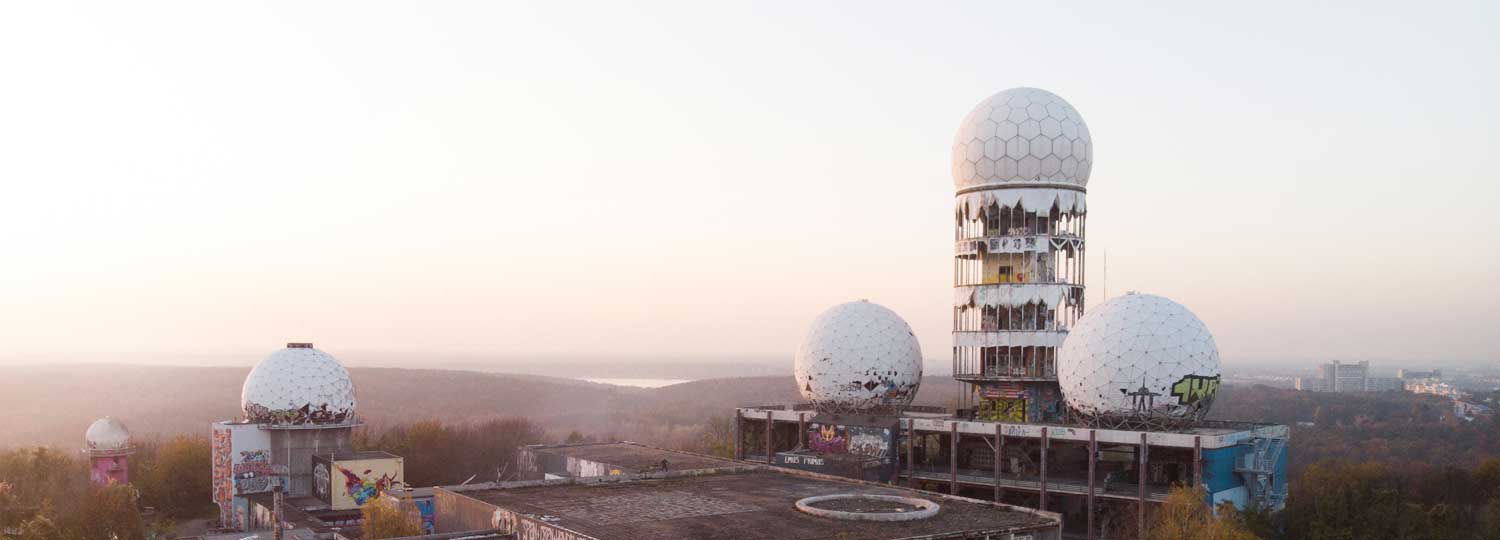Discover the history of Teufelsberg
From the ruins of World War II to its present status as a hub of art and culture. Learn about the evolution of Teufelsberg over time and join us on a journey through the past of this unique location!
Would you like more information about the exciting history of Teufelsberg?
Then visit our “Declassified” exhibition, which is included in the admission price!
November 27, 1937
Wehrtechnische Fakultät
Adolf Hitler lays the foundation stone for a building between Heerstraße and Teufelssee that is intended to stand for the next 1000 years: The “Wehrtechnische Fakultät” (Military Technical Faculty) of the Berlin Institute of Technology. This is where engineers should research armaments and warfare. After the laying of the foundation stone, construction work accelerates and relatively quickly, the shell of the main building with its four corner towers is erected.
February 1940
Reichsmarschall Hermann Göring orders the cessation of all “militarily insignificant” construction projects, including work on the “Wehrtechnische Fakultät.” Thus, the buildings remain in the shell state, awaiting completion after the “final victory.” However, the “monument of German strength” would never witness a single lecture.
February 1940
1946
The war is over, Berlin lies in ruins. In search of a suitable rubble dump, the Senate decides on the Grunewald and the barely destroyed shell of the “Wehrtechnische Fakultät” as a stable foundation for the embankment. The birth of the Teufelsberg.
1950
Embankment of the Teufelsberg
The embankment of the Teufelsberg begins. From now on, 800 trucks loaded with 7,000 tons of rubble traverse the Teufelsberg daily, piling up 26 million cubic meters in the Grunewald over the next 22 years. In 1952, the planting of the Teufelsberg also begins, involving 480,000 trees and 40,000 shrubs.
1950
1961 - 1963
Military use of the Teufelsberg
Americans and Britons negotiate an agreement for the military use of the Teufelsberg. The American occupying forces gain control of the mountain, while the British military are allowed joint use of the site.
1969 - 1971
The Teufelsberg radar station
The Americans construct a permanent building complex, from which they conduct round-the-clock surveillance activities starting in 1972 – the Teufelsberg radar station. For the next 20 years, this building complex with its antennas is utilized by American and British intelligence services for reconnaissance work. During this time, approximately 1500 people work on the premises.
1969 - 1971
1971-1992
Active operation of the Teufelsberg listening station
The Teufelsberg becomes one of the most important locations for the United States’ National Security Agency (NSA) outside the United States. The facility monitors Soviet and Eastern Bloc communications and gathers important information on the activities of Warsaw Pact countries.
1992
Operation of the Teufelsberg listening station is discontinued
With the end of the Cold War and advances in satellite communications, the traditional methods of eavesdropping used at the Teufelsberg station become increasingly obsolete. The facility is no longer considered necessary and is decommissioned.
1992
1992 – 1996
Creative activities emerge on the premises
After the closure, the site of the old listening station lies dormant. During this time, various initiatives and groups temporarily occupy the abandoned buildings, including artists, alternative cultural projects, and graffiti artists. The buildings become a meeting point for Berlin’s alternative scene, and many creative activities emerge on the premises.
1996
Purchases the property by an investor group
An investor group purchases the property for 5.2 million German marks with the intention of building luxury apartments and a hotel with conference rooms. They obtain planning permission and begin construction work.
1996
1996-2000
Planned development fails
Due to planning permission issues and resistance from residents and activists, the planned development of the Teufelsberg fails. Several attempts are made to sell the property and demolish the buildings, both without success. Meanwhile, interest from artists in the Teufelsberg steadily increases, and numerous street art works emerge on the decommissioned buildings.
2000-present
planning permission 1996 expires, gallery for street art and preserving the buildings as monument of the Cold War
In 2004, the planning permission granted in 1996 expires. The Teufelsberg becomes uninteresting for many investment projects and continues to evolve into a focal point of the street art scene. On October 30, 2018, the Teufelsberg is placed under monument protection by the State Monument Authority of Berlin. The area is now operated as a gallery for street art. The space is curated, and in recent years, many renowned artists have left their mark on the Teufelsberg. The focus remains on promoting art and preserving the buildings as an important monument of the Cold War.
2000-present

